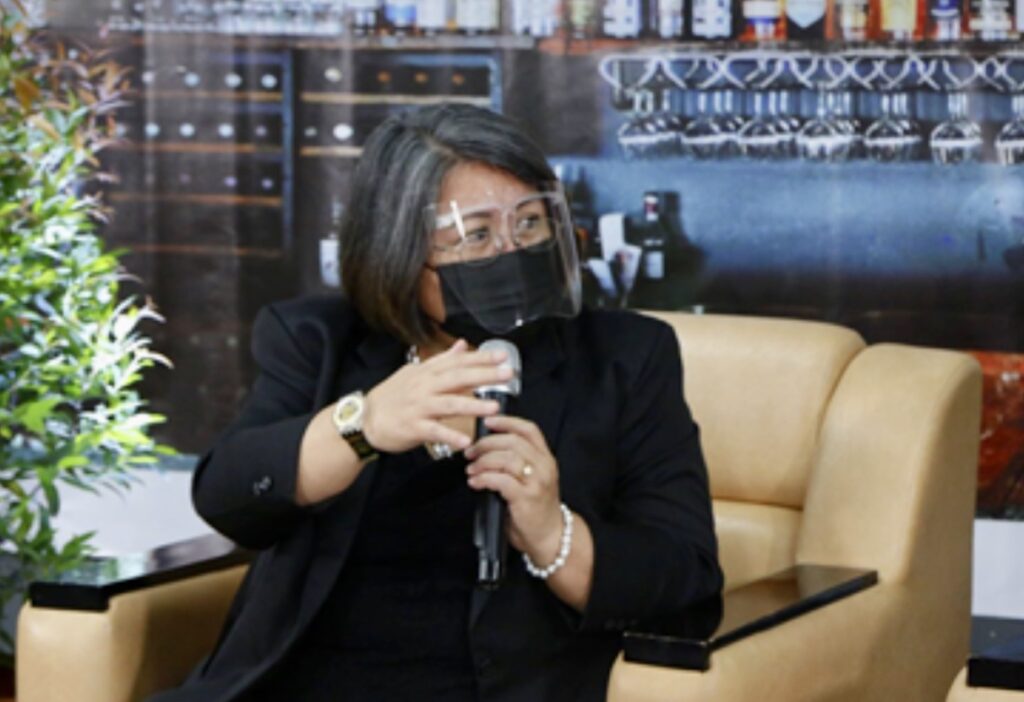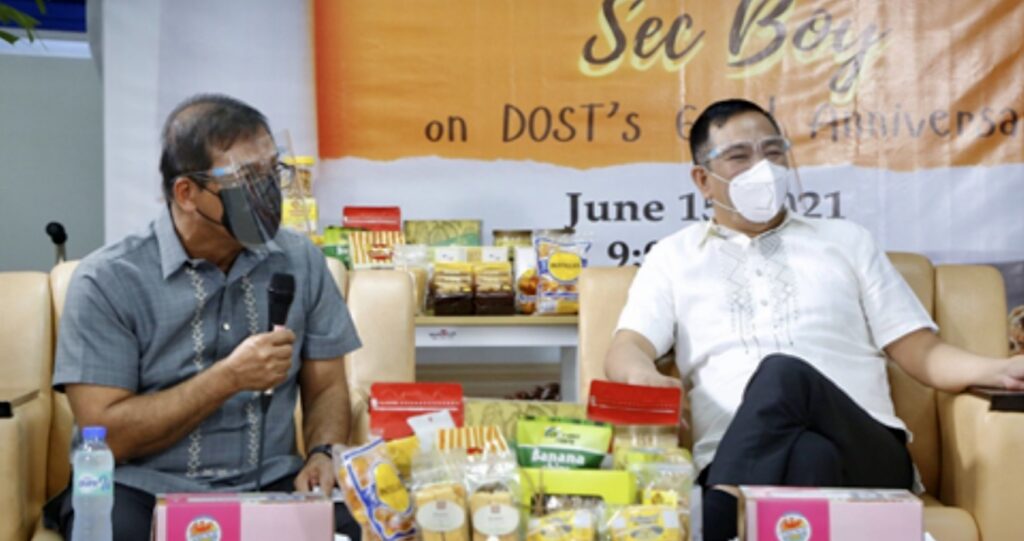By Henrylito D. Tacio
From suka (vinegar) and toyo (soy sauce) to technopreneurship, the Department of Science and Technology (DOST) has gone a long, long way. Now, in its 63rd year, the DOST is now one of the government’s highly respected executive departments.
The DOST is responsible for the coordination of science and technology-related projects in the Philippines. In addition, it is responsible for the formulation of policies and projects in the fields of science and technology in support of national development.
During a light conversation in a special online chat called “Coffee Chat with Sec Boy,” commemorating the department’s 63 years of its existence, Secretary Fortunato T. de la Peña said that DOST was “chided as S&T, Suka and Toyo.”
Today, the DOST is no longer just for suka or toyo, but in reality, it has soared high with its many accomplishments through the years. In fact, the DOST is behind most of the big-ticket research and development (R&D) activities in the country.
The DOST was formed as the National Science Development Board (NSDB) during the administration of President Carlos P. Garcia on June 13, 1958. Dr. Frank Co Tui, who was tasked by Garcia to conduct a survey regarding the state of science and technology in the country, recommended establishing a science body. As a result of that recommendation, a law was passed in Congress establishing NSDB.
On March 17, 1981, the NSDB was reorganized and given broader policy-making and program implementation functions. Thus, the National Science and Technology Authority (NSTA) came into existence.

Rowena Christina Guevarra 
Dr Renato U Solidum Jr and Engr Sancho A Mabborang
Six years later, on January 30, 1987, at the time when Corazon C. Aquino was the president, the NSTA was elevated to cabinet-level status with the signing of Executive Order 128 and was renamed Department of Science and Technology.
The DOST has ten functions. The first five functions are: formulate and adopt a comprehensive National Science and Technology Plan, and monitor and coordinate its funding and implementation; promote, assist and, where appropriate, undertake scientific and technological R&D in areas identified as vital to the country’s development; promote the development of indigenous technology and the adaptation and innovation of suitable imported technology, and in this regard, undertake technology development up to commercial-stage; undertake design and engineering works to complement research and development functions; and promote, assist and, where appropriate, undertake the transfer of the results of scientific and technological R&D to their end-users.
The remaining five functions are: promote, assist, and, where appropriate, undertake the technical services needed by agriculture, industry, transport, and the general public; develop and maintain an information system and databank on science and technology; develop and implement programs for strengthening scientific and technological capabilities through manpower training, infrastructure, and institution-building; promote public consciousness in science and technology; and undertake policy research, technology assessment, feasibility, and technical studies.
During a special online chat, De la Peña relayed how the two decades of DOST were devoted to the Human Resource Development program. He also recalled the year 1958, which marked the start of collaborative research that was done in Sta. Barbara with the Department of National Defense on cloudseeding. That very same year, the country started its geothermal energy research by the Commission on Volcanology, the predecessor of the Philippine Institute of Volcanology and Seismology (PHIVOLCS).
In later years, some agencies from other departments were added to DOST, including the Forest Product Research Institute that was originally part of the Department of the Environment and Natural Resources (DENR) and the Metals Industry Research and Development Center, and the Philippine Textile Research Institute, which were part of the Department of Trade and Industry (DTI).
“In the 80’s, this was the time that I joined DOST, and saw the transition from the NSDB and became the NSTA, which already has administrative supervision over several institutes,” said de la Peña, who had been serving the agency for 40 years already.
That decade, two more sectoral research councils on industry and energy, and health were created. Prior to that, the Philippine Council for Agricultural Research was established in 1978. “That was the time that we started contract research and adopted the ‘demand-pull’ strategy for R&D,” recalled De la Peña.
Now known as Philippine Council for Agriculture, Aquatic and Natural Resources Research and Development (PCAARRD), it is a research strategy where R&D institutes develop technologies based on what sector it serves.
“This was the time when products that are not really high-tech(nology) but are useful to the people,” said De la Peña. “I remember, they were sort of chiding us by saying that S&T is suka and toyo (vinegar and soy sauce) because we were promoting, at that time, because people needed that, at a time we were processing their agricultural products.”
So many have changed through the years since DOST first existed.
“From 2011 to 2016, ang R&D funding ng DOST increased from P1-billion to P7-billion,” said Dr. Rowena Cristina L. Guevara, Undersecretary for Research and Development. She disclosed that since the implementation of the Science for Change program, the country had established 35 Niche Centers in the Regions for R&D, which enables Higher Education Institutions to develop their own R&D initiatives to spur developments in the regions through the technologies developed under the program.
Because of this thrust, the country’s ranking in the Global Innovation Index improved in 2020, ranking 50th among the 131 economies from rank 100th in 2014.
“We are considered as efficient innovators,” pointed out Guevara. “Kasi ang input natin ay hindi gaano kalakihan pero grabe naman ang output natin.”
In recent years, the country also forayed in space science that enabled Filipino scientists and engineers to develop and deploy into space the Philippines’ first microsatellites Diwata 1 in 2016 and Diwata 2 in 2018. With the success of the first two microsatellites, the DOST once again sent into outer space the first nanosatellites called Maya 1 in June 2018 and Maya 2 last February this year.
These encouraging achievements led to the eventual birth of the Philippine Space Agency, the government agency mandated to promote and develop the country’s space technologies, capabilities, and applications. The agency is now headed by the former director of the Advanced Science and Technology Institute of the DOST.
“The Advanced Science and Technology Institute has ventured into environmental surveillance, that is how good the Filipinos are? Before, fairies can only be found in the forest, now fairies can now be found in space (referring to the Diwata 1 and 2 satellites) and a sparrow (Maya bird) that fly low from the ground but now it hovers over space as the Maya satellite),” said Undersecretary Renato U. Solidum Jr.
He also shared the many developments over the years as DOST, through its attached institutes PHIVOLCS and the Philippine Atmospheric, Geophysical, and Astronomical Services Administration (PAGASA), have efficiently forecasted and monitored various natural disasters through the use of knowledge products and weather and geohazards forecasting technologies.
“Today, PHIVOLCS can now remotely monitor volcanoes,” Solidum pointed out. “We have near real-time volcano monitoring stations, where we can monitor all the volcanoes in our facility in Quezon City,” revealed by the country’s premier’ fault finder’.”
According to Solidum, the country now has 109 earthquake monitoring stations from just ten sometime in the ’80s. Aside from this, 29 sea-level monitoring stations for tsunami monitoring were established, while in earlier years, PAGASA, the State Weather Forecasting Bureau, used rain gauges to gather rain from buckets.
“But now we have 17 doppler radars that can forecast typhoons from a distance of 200 kilometers and 13 flood forecasting and warning centers with additional five more being constructed,” he said.
On the other hand, DOST Undersecretary for Regional Operations Sancho A. Mabborang highlighted the success of DOST’s Small Enterprise Technology Upgrading Program (SETUP), a nationwide program that empowers micro, small and medium enterprises to be more productive and competitive.
Mabborang reported that since 2002 when the program was launched, they have already assisted 90,000 small to medium enterprises and generated additional 290,000 jobs, mostly in the countryside.
Aside from this, he bannered the Food Innovation Centers, mostly found inside the campuses of state universities and colleges in the regions, that conduct collaborative R&D activities and other support services that enable development in the food sector. As a result, the centers were able to create new products and technologies that helped spur new developments for SMEs and enliven economic activity in the regions.
As the science department marks its more than six decades of serving the people through science, technology, and innovation, the thousands of men and women of science continue to pledge their full support and dedication to improving the lives of every Filipino in the future beyond the new normal.
(Sources: Text were mostly from a feature written by Joy M. Lazcano of DOST-STII and Wikipedia. Photos courtesy of DOST’s Henry A. De Leon)

